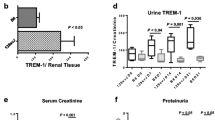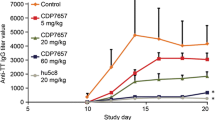Abstract
Lupus nephritis (LN) is characterized by an increased upregulation of Th1. This study was undertaken to evaluate the role of CD134 in cytokine production in peripheral blood mononuclear cells (PBMCs) from subjects with LN. Percentages of IFN-γ- (Th1), IL-4-, and IL-10- (Th2) producing cells within the PBMC CD4+ T cell population of LN subjects were found to be higher than those of healthy subjects. Stimulation of PBMC from LN subjects with anti-CD3 ε mAb/rIL-2 resulted in further increases in cytokine production. Stimulation in the presence of anti-CD134 mAb resulted in reduced IL-4 and IL-10 production; however, it also resulted in increased IFN-γ production. Stimulation in the presence of the fusion protein rhCD134:Fc resulted in decreased production of all three cytokines. The possibilities that anti-CD134 therapy may control the extent of IL-4- and IL-10-mediated damage in active LN and that rhCD134:Fc therapy may prevent occurrence of LN are discussed.


Similar content being viewed by others
References
Weinberg AD, Evans DE, Thalhofer C, Shi T, Prell RA (2004) The generation of T cell memory: a review describing the molecular and cellular events following OX40 (CD134) engagement. J Leukoc Biol 75:962–972. doi:10.1189/jlb.1103586
Watts TH (2005) TNF/TNFR family members in costimulation of T cell responses. Annu Rev Immunol 23:23–68. doi:10.1146/annurev.immunol.23.021704.115839
Weinberg AD (2002) OX40: targeted immunotherapy—implications for tempering autoimmunity and enhancing vaccines. Trends Immunol 23:102–109. doi:10.1016/S1471-4906(01)02127-5
Ohshima Y, Yang LP, Uchiyama T et al (1998) OX40 costimulation enhances interleukin-4 (IL-4) expression at priming and promotes the differentiation of naive human CD4+ T cells into high IL-4 producing effectors. Blood 92:3338–3345
Akiba H, Miyahira Y, Atsuta M, Takeda K, Nohara C, Futagawa T et al (2000) Critical contribution of OX40 ligand to T helper cell type 2 differentiation in experimental leishmaniasis. J Exp Med 191:375–380. doi:10.1084/jem.191.2.375
Aten J, Roos A, Claessen N, Schilder-Tol EJ, Ten Berge IJ, Weening JJ (2000) Strong and selective glomerular localization of CD134 ligand and TNF receptor-1 in proliferative lupus nephritis. J Am Soc Nephrol 11:1426–1438
Tucci M, Calvani N, Richards HB, Quatraro C, Silvestris F (2005) The interplay of chemokines and dendritic cells in the pathogenesis of lupus nephritis. Ann N Y Acad Sci 1051:421–432. doi:10.1196/annals.1361.084
Arringer M, Smolen JS (2005) Cytokine expression in lupus kidneys. Lupus 14:13–18. doi:10.1191/0961203305lu2053oa
Chan RW, Lai FM, Li EK, Tam LS, Chow KM, Li PK et al (2007) Intrarenal cytokine gene expression in lupus nephritis. Ann Rheum Dis 66:886–892. doi:10.1136/ard.2006.063123
Nakashima H, Akahoshi M, Masutani K (2006) Th1/Th2 balance of SLE patients with lupus nephritis. Rinsho Byori 54:706–713
Higgins LM, McDonald SA, Whittle N et al (1999) Regulation of T cell activation in vitro and in vivo by targeting the OX40-OX40 ligand interaction: amelioration of ongoing inflammatory bowel disease with an OX40-IgG fusion protein, but not with an OX40 ligand-IgG fusion protein. J Immunol 162:486–493
Arch RH, Thompson CB (1998) 4–1 BB and OX40 are members of a tumor necrosis factor (TNF)-nerve growth factor receptor subfamily that bind TNF receptor-associated factors and activate nuclear factor κB. Mol Cell Biol 18:558–565
Odobasic D, Kitching AR, Tipping PG, Holdsworth SR (2005) CD80 and CD86 costimulatory molecules regulate crescentic glomerulonephritis by different mechanisms. Kidney Int 68:584–594. doi:10.1111/j.1523-1755.2005.00436.x
Patschan S, Dolff S, Kribben A, Durig J, Patschan D, Wilde B et al (2006) CD134 expression on CD4+ T cells is associated with nephritis and disease activity in patients with systemic lupus erythematosus. Clin Exp Immunol 145:235–242. doi:10.1111/j.1365-2249.2006.03141.x
Ye RG (2000) Systemic lupus erythematosus. In: Textbook of internal medicine. People’s Publishing House of Public Health, Beijing City, pp 909–915
Bombardier C, Gladman DD, Urowitz MB, Caron D, Chang CH (1992) Derivation of the SLEDAI: a disease activity index for lupus patients. The committee on prognosis studies in SLE. Arthritis Rheum 35:630–640. doi:10.1002/art.1780350606
Chang AE, Aruga A, Cameron MJ, Sondak VK, Normolle DP, Fox BA et al (1997) Adoptive immunotherapy with vaccine-primed lymph node cells secondarily activated with anti-CD3 and interleukin-2. J Clin Oncol 15:796–807
Huang H, Yu H, Xiong SD (2001) Enhancement of anti-CD4 mAb on anti-tumor activity of tumor-specific T cells activated by rIL-2 and anti-CD3 mAb. J Cell Mol Immunol 17:160–164
Yi-wei C, Fox BA (2001) Induction of tumor-specific Th1 cell response in vitro by anti-OX-40 and anti-IL-4. Shanghai J Immunol 21:148–150 Chinese
Zhou YB, Li YJ, Wu YH (2006) Study on the levels in the serum and mRNA expression in PBMCs of interleukin-10 and interferon-γ of patients with lupus nephritis. China J Mod Med 16:529–532 Chinese
Pillet MJ, Mempel TR (2008) Regulation of T-cell migration and effector functions: insight in in vivo imaging studies. Immunol Rev 221:107–129. doi:10.1111/j.1600-065X.2008.00584.x
Weinberg AD, Thalhofer C, Morris N, Walker JM, Seiss D, Wong S et al (1997) Anti-OX40 (CD134) administration to nonhuman primates: immunostimulatory effects and toxicokinetic study. J Immunother 29:575–585. doi:10.1097/01.cji.0000211319.00031.fc
Totsuka T, Kanai T, Uraushihara K, Iiyama T, Yamazaki M, Akiba H et al (2003) Therapeuetic effect of anti-OS40L and anti-TNF-alpha MAbs in a murine model of chronic colitis. Am J Physiol Gastrointest Liver Physiol 284:G595–G603
Yuan X, Salama AD, Dong V, Schmitt I, Najafian N, Chandraker A et al (2003) The role of the CD134-CD134 ligand costimulatory pathway in alloimmune responses in vivo. J Immunol 170:2949–2955
Blazar BR, Sharpe AH, Chen AI, Panoskaltsis-Mortari A, Lees C, Akiba H, Yagita H, Killeen N, Taylor PA (2003) Ligation of OX40 (CD134) regulates graft-versus-host disease (GVHD) and graft rejection in allogeneic bone marrow transplant recipients. Blood 101:3741–3748
Yoshioka T, Nakajima A, Akiba H, Ishiwata T, Asano G, Yoshino S et al (2000) Contribution of OX40/OX40 ligand interaction to the pathogenesis of rheumatoid arthritis. Eur J Immunol 30:2815–2823. doi:10.1002/1521-4141(200010)30:10<2815::AID-IMMU2815>3.0.CO;2-#
Taylor L, Bachler M, Duncan I, Keen S, Fallon R, Mair C et al (2002) In vitro and in vivo activities of OX40 (CD134)-IgG fusion protein isoforms with different levels of immune-effector functions. J Leukoc Biol 72:522–529
Curry AJ, Chikwe J, Smith XG, Cai M, Schwarz H, Bradley JA et al (2004) OX40 (CD134) blockade inhibits the co-stimulatory cascade and promotes heart allograft survival. Transplantation 78:807–814. doi:10.1097/01.TP.0000131670.99000.54
Kjaergaard J, Wang LX, Kuriyama H, Shu S, Plautz GE (2005) Active immunotherapy for advanced intracranial murine tumors by using dendritic cell-tumor cell fusion vaccines. J Neurosurg 103:156–164
Morris NP, Peters C, Montler R, Hu HM, Curti BD, Urba WJ et al (2007) Development and characterization of recombinant human Fc:OX40L fusion protein linked via a coiled-coil trimerization domain. Mol Immunol 44:3112–3121. doi:10.1016/j.molimm.2007.02.004
Gramaglia I, Weinberg AD, Lemon M et al (1998) OX-40 ligand: a potent costimulatory molecule for sustaining primary CD4 T cell reponses. J Immunol 161:6510–6517
Weinberg AD, Rivera MM, Prell RJ et al (2000) Engagement of the OX-40 receptor in vivo enhances antitumor immunity. J Immunol 164:2160–2169
Rogers PR, Song J, Gramaglia I et al (2001) OX40 promotes Bcl-XL and Bcl-2 expression and is essential for long-term survival of CD4 T cells. Immunity 15:445–455. doi:10.1016/S1074-7613(01)00191-1
Maxwell JR, Weinberg A, Prell RA et al (2000) Danger and OX40 receptor signaling synergize to enhance memory T cell survival by inbibiting peripheral deletion. J Immunol 164:107–112
Li M, Zhang Y (2006) Effect of antibody to CD134 on perforin-mediated cytolysis in human peripheral blood mononuclear cells. Hybridoma 25:145–153. doi:10.1089/hyb.2006.25.145
Takeda I, Ine S, Killeen N et al (2004) Distinct roles for the OX40-OX40 ligand interaction in regulatory and nonregulatory T cells. J Immunol 172:3580–3589
Agarwal SK, Marshall GD Jr (2001) Dexamethasone promotes type 2 cytokine production primarily through inhibition of type 1 cytokines. J Interferon Cytokine Res 21:147–155. doi:10.1089/107999001750133159
Amit M, Mor A, Weissgarten J, Rosenberg R, Ramot Y, Wysenbeek AJ et al (2000) Inactive systemic lupus erythematosus is associated with a normal stimulated Th(1)/Th(2) cytokine secretory pattern. Cytokine 12:1405–1408. doi:10.1006/cyto.2000.0724
Akahoshi M, Nakashima H, Tanaka Y, Kohsaka T, Nagano S, Ohgami E et al (1999) Th1/Th2 balance of peripheral T helper cells in systemic lupus erythematosus. Arthritis Rheum 42:1644–1648. doi:10.1002/1529-0131(199908)42:8<1644::AID-ANR12>3.0.CO;2-L
Author information
Authors and Affiliations
Corresponding author
Rights and permissions
About this article
Cite this article
Zhou, Yb., Ye, Rg., Li, Yj. et al. Targeting the CD134–CD134L interaction using anti-CD134 and/or rhCD134 fusion protein as a possible strategy to prevent lupus nephritis. Rheumatol Int 29, 417–425 (2009). https://doi.org/10.1007/s00296-008-0697-2
Received:
Accepted:
Published:
Issue Date:
DOI: https://doi.org/10.1007/s00296-008-0697-2




